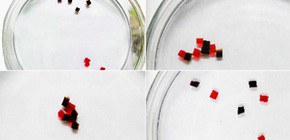
Reversible self-assembly of gels through metal-ligand interactions
Under the leadership of HARADA Akira , Director, Project Research Center for Fundamental Sciences, and Professor, Graduate School of Science, Osaka University, a group of researchers have demonstrated the reversibility of self-assemblies of gels formed via metal-ligand interactions using polyacrylamide modified with Fe-porphyrin and L-histidine moieties.
L-histidine and Fe-porphyrin (heme) gels were added to a solution of Tis-acetate buffer. As shown in the image below, the situation changed from "a" to "b" following agitation of the mixture. However, when histidine solution was added to the assembly, the materials dissociated (as in "b" to "c"). Then, when these gels were washed and placed again in the original solution, the materials reassembled (from "c" to "d" in the picture).
Thus, in what may be a world first, this group succeeded in demonstrating a reversible mechanism for assembly and dissociation of gels using metal-ligand interactions.
Abstract
Metal-ligand interactions with various proteins form in vivo metal assemblies. In recent years, metallosupramolecular approaches have been utilized to forge an assortment of fascinating two- and three-dimensional nano-architectures, and macroscopic materials, such as metal-ligand coordination polymeric materials, have promise in artificial systems. However to the best of our knowledge, the self-assembly of macroscopic materials through metal-ligand interactions has yet to be reported. Herein we demonstrate a gel assembly formed via metal-ligand interactions using polyacrylamide modified with Fe-porphyrin and L-histidine moieties. The stress values for the assembly increase as the concentration of Fe-porphyrin or L-histidine in the gels increases. Moreover, agitation of Fe-porphyrin gel, Zn-porphyrin gel, and L-histidine gel in an 80 mM Tris-acetate buffer (pH 9.0) results in selective adhesion of the Fe-porphyrin gel to the L-histidine gel based on the affinities of Fe-porphyrin and Zn-porphyrin with L-histidine.

Figure 1
To learn more about this research, please read the full research report entitled "Reversible self-assembly of gels through metal-ligand interactions" at this page of the Scientific Reports website.
Related link:
